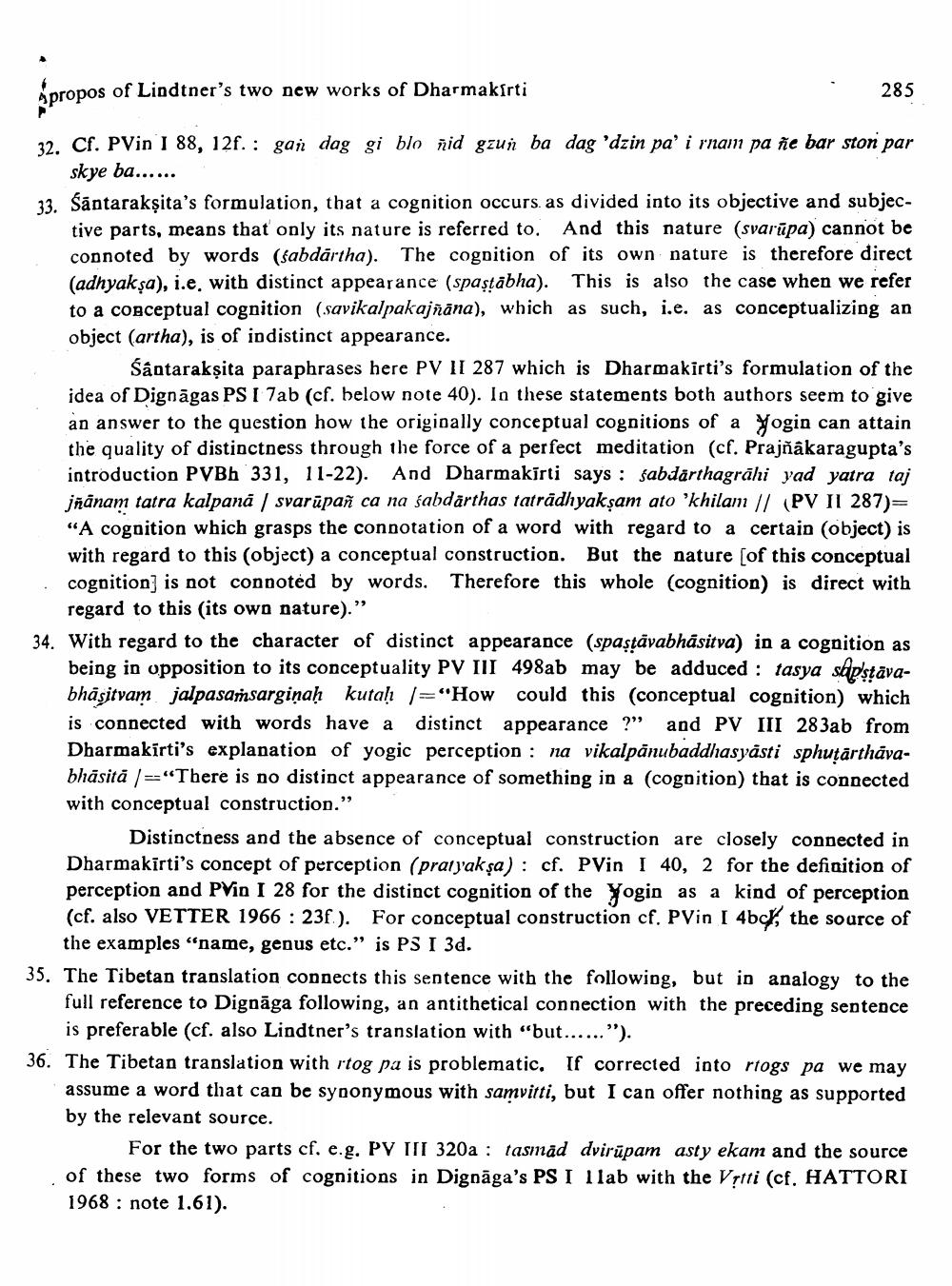________________
Apropos of Lindtner's two new works of Dharmakirti
.
285
32. Cf. PVin I 88, 12f. : gan dag gi blo ñid gzun ba dag 'dzin pa' i rnam pa ñe bar ston par
skye ba...... 33. Sāntarakṣita's formulation, that a cognition occurs. as divided into its objective and subjec
tive parts, means that only its nature is referred to. And this nature (svarūpa) cannot be connoted by words (sabdārtha). The cognition of its own nature is therefore direct (adhyak şa), i.e, with distinct appearance (spastabha). This is also the case when we refer to a conceptual cognition (savikalpakajñāna), which as such, i.e. as conceptualizing an object (artha), is of indistinct appearance.
Santarakṣita paraphrases here PV II 287 which is Dharmakirti's formulation of the idea of Dignāgas PS I 7ab (cf. below note 40). In these statements both authors seem to give an answer to the question how the originally conceptual cognitions of a Yogin can attain the quality of distinctness through the force of a perfect meditation (cf. Prajñākaragupta's introduction PVBh 331, 11-22). And Dharmakīrti says : sabdarthagrāhi yad yatra taj jñānam tatra kalpana / svarūpañ ca na sabdarthas tatrādhyakşam ato khilam // (PV II 287)= "A cognition which grasps the connotation of a word with regard to a certain (object) is with regard to this (object) a conceptual construction. But the nature of this conceptual cognition] is not connoted by words. Therefore this whole (cognition) is direct with
regard to this (its owo nature).” 34. With regard to the character of distinct appearance (spaștāvabhāsitva) in a cognition as
being in opposition to its conceptuality PV III 498ab may be adduced : tasya sapstāvabhasitvam jalpasamsargiņaḥ kutah /="How could this conceptual cognition) which is connected with words have a distinct appearance ?" and PV III 283ab from Dharmakīrti's explanation of yogic perception : na vikalpānubaddhasyasti sphuţarthāvabhāsită / --“There is no distinct appearance of something in a (cognition) that is connected with conceptual construction."
Distinctness and the absence of conceptual construction are closely connected in Dharmakirti's concept of perception (pratyak şa) : cf. PVin [ 40, 2 for the definition of perception and Pyin I 28 for the distinct cognition of the Yogin as a kind of perception (cf. also VETTER 1966 : 23f). For conceptual construction cf. PVin [ 4b, the source of
the examples "name, genus etc." is PS I 3d. 35. The Tibetan translation connects this sentence with the following, but in analogy to the
full reference to Dignāga following, an antithetical connection with the preceding sentence
is preferable (cf. also Lindtner's translation with “but......"). 36. The Tibetan translation with rtog pa is problematic. If corrected into rtogs pa we may
assume a word that can be synonymous with samvitti, but I can offer nothing as supported by the relevant source.
For the two parts cf. e.g. PV III 320a : tasmad dvirūpam asty ekam and the source of these two forms of cognitions in Dignāga's PS I llab with the Vrtti (cf. HATTORI 1968 : note 1.61).




